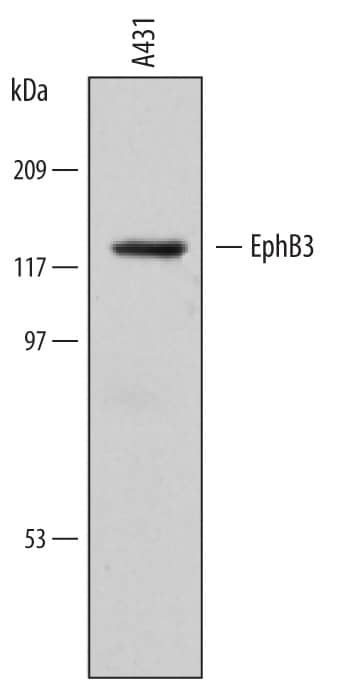Human EphB3 Antibody
R&D Systems, part of Bio-Techne | Catalog # MAB5667

Key Product Details
Species Reactivity
Applications
Label
Antibody Source
Product Specifications
Immunogen
Leu38-Ala550
Accession # P54753
Specificity
Clonality
Host
Isotype
Scientific Data Images for Human EphB3 Antibody
Detection of Human EphB3 by Western Blot.
Western blot shows lysates of human cerebellum tissue. PVDF membrane was probed with 2 µg/mL of Mouse Anti-Human EphB3 Monoclonal Antibody (Catalog # MAB5667) followed by HRP-conjugated Anti-Mouse IgG Secondary Antibody (Catalog # HAF018). A specific band was detected for EphB3 at approximately 130 kDa (as indicated). This experiment was conducted under reducing conditions and using Immunoblot Buffer Group 1.Applications for Human EphB3 Antibody
Western Blot
Sample: Human cerebellum tissue
Reviewed Applications
Read 1 review rated 4 using MAB5667 in the following applications:
Formulation, Preparation, and Storage
Purification
Reconstitution
Formulation
Shipping
Stability & Storage
- 12 months from date of receipt, -20 to -70 °C as supplied.
- 1 month, 2 to 8 °C under sterile conditions after reconstitution.
- 6 months, -20 to -70 °C under sterile conditions after reconstitution.
Background: EphB3
EphB3, also known as Cek10, Tyro6, Sek4, Hek2, and Mdk5, is a 130 kDa member of the transmembrane Eph receptor tyrosine kinase family. The A and B classes of Eph proteins are distinguished by Ephrin ligand binding preference but have a common structural organization. Eph-Ephrin interactions are widely involved in the regulation of cell migration, tissue morphogenesis, and cancer progression (1). The 526 amino acid (aa) extracellular domain (ECD) of mature human EphB3 contains a ligand binding domain followed by a cysteine rich region and two fibronectin type III domains. The 418 aa cytoplasmic domain contains a tyrosine kinase domain, a sterile alpha motif (SAM), and a PDZ binding motif (2). Within the ECD, human EphB3 shares 96% aa sequence identity with mouse and rat EphB3. Binding of EphB3 to its ligands Ephrin-B1, B2, and B3 triggers forward signaling through EphB3 as well as reverse signaling through the Ephrin (1, 3). EphB3 also interacts in cis with the receptor tyrosine kinase Ryk (4). Activation of its kinase is required for some but not all of the effects of EphB3 on cellular adhesion, motility, and morphology (5). EphB3 is widely expressed during development and in the adult; it shows a complementary tissue distribution to the Ephrin-B ligands (6‑9). EphB3 function is important in vascular, nervous system, thymocyte, and palate development (6, 7, 10‑12). It directs embyronic neuronal axon pathfinding, and its upregulation on local macrophages following neuronal injury promotes the growth of regenerating axons (10, 13). EphB3 inhibits colorectal carcinogenesis and invasion by preventing the migration of tumor cells out of the intestinal crypt (9, 14). EphB3 function is supported by the cooperative action of EphB2 in several of these processes (6, 10‑12, 15).
References
- Pasquale, E.B. (2008) Cell 133:38.
- Bohme, B. et al. (1993) Oncogene 8:2857.
- Pasquale, E.B (2004) Nat. Neurosci. 7:417.
- Trivier, E. and T.S. Ganesan (2002) J. Biol. Chem. 277:23037.
- Miao, H. et al. (2005) J. Biol. Chem. 280:923.
- Adams, R.H. et al. (1999) Genes Dev. 13:295.
- Krull, C.E. et al. (1997) Curr. Biol. 7:571.
- Willson, C.A. et al. (2006) J. Mol. Histol. 37:369.
- Cortina, C. et al. (2007) Nature Genet. 39:1376.
- Birgbauer, E. et al. (2000) Development 127:1231.
- Alfaro, D. et al. (2008) Immunology 125:131.
- Risley, M. et al. (2009) Mech. Dev. 126:230.
- 13. Liu, X. et al. (2006) J. Neurosci. 26:3087.
- 14. Batlle, E. et al. (2005) Nature 435:1126.
- 15. Holmberg, J. et al. (2006) Cell 125:1151.
Long Name
Alternate Names
Gene Symbol
UniProt
Additional EphB3 Products
Product Documents for Human EphB3 Antibody
Product Specific Notices for Human EphB3 Antibody
For research use only
